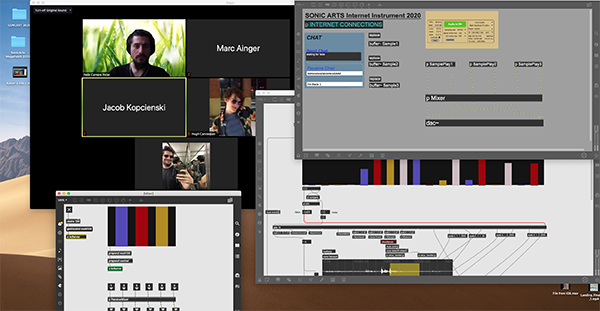Marc Ainger, an associate professor in the School of Music, has been working with a team and collaborating with the Advanced Computer Center for Art and Design (ACCAD) since March to develop software that reduces the latency of live audio streams and makes you feel like you’re in the same room as other musicians.
Also importantly, their software increases the sound quality from a highly compressed version you would get on Zoom to uncompressed audio that is CD quality or better.
Ainger has been part of a large international effort working on this problem since March. Combined with researchers at Stanford University, the University of California San Diego as well as others in Austria, Germany and Argentina, the software improved over the course of the spring and summer.
In three sessions per week over the summer, the group got together to test different versions. They held weekly improvisation sessions as well, “jamming” with digital music first before improving the technology enough to make vocals and music with instruments possible.
Ainger’s Sonic Arts Ensemble tried out the latest version of the technology when classes began in late August. He had five students in the class, all with various quality internet connections. The results were noticeable to the students right away.
“The students felt the power of the experience immediately. ‘Wow, the sound is great, and it really is like you’re in the room.’”
With a basic software in place for audio collaboration over the internet, the future possibilities have really opened up. Ainger plans to have live shows using their software later in the fall. . .
“There’s a certain kind of music that you could create on this medium that you could not create other places,” Ainger said. “Rather than say, ‘How can we perform Beethoven on this?’ I would rather say, ‘What can we perform that’s as exciting as Beethoven on this medium?’ What can a virtual concert hall do that a real one can’t?”
More than anything, Zuniga Shaw hopes this technology can help strengthen human bonds. Week by week during the spring and summer, she saw the way live collaboration enhanced the well-being of everyone involved. Humans love making sound together – laughter, applause, singing and music – and that opportunity has really dropped off during the pandemic, she said.
“Because society at large is now realizing the stakes in our digital lives, there’s a radically enhanced and expanded audience for the intellectual and creative work of this kind of performance,” Zuniga Shaw said. “This is an example of a way that we can and should be pushing on our technologies to be more humane and to advance our lives and well-being, not just corporate profits.”
ANALYSIS
It is exciting to see that research within my focused problem space is being conducted so close to home. I am hopeful that this means that pertinent information is just around the corner and that a valuable solution is just as close.
This article is included because it highlights efforts being made to improve the viability of current tools for remote musical collaboration. I was unaware that experiences had on tools like Zoom could be modified by user created add-ons or plugins. This example opens up doors of thought for other solutions involving successful, readily available products.
Additionally, important questions are raised in the article that are vital to the successful usage of tools like this:
“Could the software be simple enough for everyone to figure out with minimal confusion? Could the technology work across huge, international distances as well as it would between neighborhoods in Columbus?”
These questions are essential to the feasibility of the solution being usable by artists. If either question is no, then collaboration will be at best be replaced with the resurgence of in person meetings.




